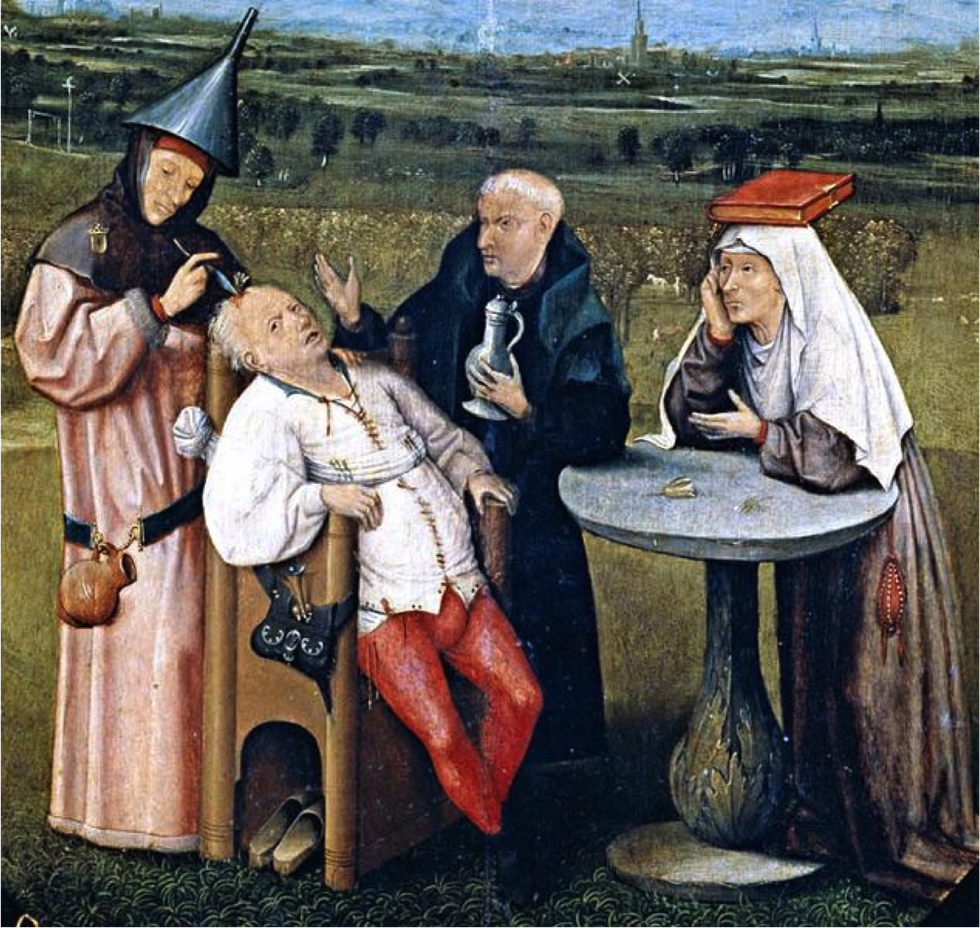Throughout human history, many cultures have viewed mental illness as a form of religious punishment or demonic possession. In ancient Egyptian, Indian, Greek, and Roman writings, mental illness was characterized as a personal or religious dilemma. In the fifth century B.C., ancient Greek physician Hippocrates was a pioneer in treating the mentally ill with techniques not rooting in religion or superstition; in their place, he focused on changing a mentally ill patient’s environment or occupation or administering certain substances as medications. During the Middle Ages, mentally ill individuals were believe to be possessed by a demon or in dire need of religion. Negative attitudes toward mental illness persisted into the 18th century in the United States, leading to stigmatisation of mental illness, and unhygienic (and often degrading) confinement of the mentally ill.
The Neolithic Era
Trephining (also known as trepanning) first occurred during the Neolithic Era or the New Stone Age. During this process, a hole (or trephine) was chipped into the skull using crude stone apparatuses. Primitive humans believed that through this opening, the evil spirit(s) thought to be inhabiting the individual’s head and causing their psychopathology would be released and the afflicted would be cured. Some who underwent this procedure survived and may have continued to live on for many years afterward as trephined skulls of primitive humans showed indicators of recovery. Excessive pressure on the brain may have also incidentally been relieved. To treat various ailments such as skull fractures and migraines as well as mental illness, this process was endured through the centuries, albeit with more sophisticated tools such as skull saws and drills developed solely for this purpose.
Ancient Mesopotamia
Priest-doctors treated mentally ill individuals with magico-religious rituals as mental pathology was believed to mask demonic possession. Exorcisms, incantations, prayer, atonement, and other various mystical rituals were used to drive out the evil spirit. Other means attempted to appeal to the spirit with more human devices; threats, bribery, punishment, and sometimes submission were hoped to be an effective cure.
Ancient Egypt
Ancient Egyptians seem to be the most forward-thinking in their treatment of mental illness; they recommended that those afflicted with mental pathology engage in recreational activities such as concerts, dances, and paintings in order to relieve symptoms and achieve some sense of normalcy. The Egyptians were also quite advanced in terms of medicine, surgery, and knowledge of the human body. Two papyri dating back to the 16th century B.C.E., the Edwin Smith papyrus and the Ebers papyrus, documented early treatments of wounds, surgical operations, and identified, very likely for the first time, the brain as the site of mental functions. Despite innovative thinking about disease, these papyri also showcased that magic and incantations were used to treat illnesses that were of unknown origin, often thought to be caused by supernatural forces such as demons or disgruntled divine beings. Ancient Egyptians also shared the early Greek belief that hysteria in women (now known as conversion disorder) was caused by a “wandering uterus,” and so utilised decontamination of the vagina to lure the organ back into its proper position.
Ancient India
Ancient Hindu and Punjabi scriptures known as Ramayana and Mahabharata contained fictional descriptions of depression and anxiety states. Mental disorders were generally thought to reflect abstract metaphysical entities, supernatural agents, sorcery, or witchcraft. A work known as the Charaka Samita from circa 600 B.C., part of the Hindu Ayurveda (“knowledge of life”), saw ill health as resulting from an imbalance among three kinds of bodily fluids or forces called Dosha. Different personality types were also described, with different propensities to worries or difficulties. Suggested causes included inappropriate diet; disrespect towards the gods, instructors, elders, or others; mental shock due to excessive fear or joy; and faulty bodily activity. Treatments included the usage of herbs and ointments, charms and prayers, moral or emotional persuasion, and shocking the person.
Ancient China
Mental pathology was treated mainly under traditional Chinese medicine by herbs, acupuncture, or “emotional therapy.” The Inner Canon of the Yellow Emperor or Huandgdi Neijing, an ancient Chinese medical text, described symptoms, mechanisms, and therapies for mental illness, emphasising connections between bodily organs and emotions. Conditions were thought to comprise five stages or elements and imbalances between yin and yang. The social stigma attached to mental illness was, and to some extent still is, pronounced in countries that have strong ties to family honour and a reliance on marriages to create alliances and relieve families of burdensome daughters. In China, the mentally ill were concealed by their families for fear that the community would believe that the affliction was the result of immoral behaviour by the individual and/or their relatives. The mentally ill were also thought to have “bad fate” that would negatively influence anyone who associated with the disturbed individual, scaring away potential suitors and leading to the idea that mental illness was contagious.
Ancient Greece and Rome
Between the fifth and third centuries B.C.E., Greek physician Hippocrates denied the long-held belief that mental illness was caused by supernatural forces and instead proposed that it stemmed from natural occurrences in the human body, particularly pathology in the brain. Hippocrates, and later the Roman physician Galen, introduced the concept of the four essential fluids of the human body—blood, phlegm, bile, and black bile—the combinations of which produced the unique personalities of individuals. Historically in Greece, according to “Greek Psychiatry’s Transition from the Hospital to the Community” by Amy Blue, “a mentally ill [family] member implies a hereditary, disabling condition in the bloodline and threatens [the family’s] identity as an honourable unit,” therefore treatment of the mentally ill in these cultures meant a life of hidden confinement or abandonment by one’s family. Mentally ill vagrants were left alone to wander the streets so long as they did not cause any social disorder. Those who were deemed dangerous or unmanageable, both in family homes or on the streets, were given over to police and thrown in jails or dungeons, sometimes for life.
Ancient Hebrews and Israelites
Hebrews believed that all illness was inflicted upon humans by God as punishment for committing sin, and even demons that were thought to cause some illnesses were attributed to God’s wrath. Yet, God was also seen as the ultimate healer and, generally, Hebrew physicians were priests who had special ways of appealing to the higher power in order to cure sickness. Along the same spiritual lines, ancient Persians attributed illness to demons and believed that good health could be achieved through proper precautions to prevent and protect one from diseases. These included adequate hygiene and purity of the mind and body achieved through good deeds and thoughts.
Persia, Arabia, and the Muslim Empire
Persian and Arabic scholars were heavily involved in translating, analysing and synthesising Greek texts and concepts. As the Muslim world expanded, Greek concepts were integrated with religious thought and over time, new ideas and concepts were developed. Arab texts from this period contain discussions of melancholia, mania, hallucinations, delusions, and other mental disorders. Mental disorder was generally connected to loss of reason; writings covered links between the brain and disorders and spiritual/mystical meaning of disorders. They spoke of fear and anxiety, anger and aggression, sadness and depression, and obsessions. Under Islam, the mentally ill were considered incapable yet deserving of humane treatment and protection. Some thought mental disorder could be caused by possession by a djinn (genie), which could be either good or demon-like. There were sometimes beatings to exorcise djinn, or alternatively over-zealous attempts at cures. Islamic views often merged with local traditions. In Morocco, the traditional Berber people were animists and the concept of sorcery was integral to the understanding of mental disorder; it was mixed with the Islamic concepts of djinn and often treated by religious scholars combining the roles of holy man, sage, seer and sorcerer. The first psychiatric hospital ward was founded in Baghdad in 705, and insane asylums were built in Fes in the early 8th century, Cairo in 800, and in Damascus and Aleppo in 1270. Insane patients were treated using baths, drugs, music, and recreational activities. In the centuries to come, The Muslim world would eventually serve as a critical way station of knowledge for Renaissance Europe, through the Latin translations of many scientific Islamic texts. Ibn-Sina's (Avicenna's) Canon of Medicine became the standard of medical science in Europe for centuries, together with works of Hippocrates and Galen.
Christian Europe
Beliefs about mental illness and proper treatments were altered, and in some cases advanced, by early European thinkers. Conceptions of madness in the Middle Ages in Europe were a mixture of the divine, diabolical, magical and transcendental. Theories of Hippocrates’ four humours were applied, sometimes separately (a matter of "physic") and sometimes combined with theories of evil spirits (a matter of "faith"). Arnaldus de Villanova (1235–1313) combined "evil spirit" and Galen-oriented "four humours" theories and promoted trephining as a cure to let demons and excess humours escape. Other bodily remedies in general use included purges, bloodletting and whipping. Madness was often seen as a moral issue, either a punishment for sin or a test of faith and character. Christian theology endorsed various therapies, including fasting and prayer for those estranged from God and exorcism of those possessed by the devil. Thus, although mental disorder was often thought to be due to sin, other more mundane causes were also explored, including intemperate diet and alcohol, overwork, and grief. The care of lunatics was primarily the responsibility of the family. In England, if the family were unable or unwilling, an assessment was made by crown representatives in consultation with a local jury and all interested parties, including the subject himself or herself. The process was confined to those with real estate or personal estate, but it encompassed poor as well as rich and took into account psychological and social issues. Most of those considered lunatics at the time probably had more support and involvement from the community than people diagnosed with mental disorders today. As in other eras, visions were generally interpreted as meaningful spiritual and visionary insights; some may have been causally related to mental disorders, but since hallucinations were culturally supported they may not have had the same connections as today.
16th to 18th centuries
In the 16th century, individuals with psychological disorders were seen as dangerous; they were locked up to protect society which led to an increase in the mortality rate. Around this period, society was becoming increasingly obsessed with the concept of mental illness. This is evident through Shakespeare’s plays, but is especially evident throughout his play “Hamlet.” During the 17th century, the general consensus on mental belief was that if mad people behaved like animals, they should be treated like animals. The following treatments were advocated by neuroanatomist and physician Thomas Willis: curative discipline, fetters, blows, and medical treatments. In the eyes of the law, mentally ill individuals lacked the capacity to reason; a Court of Wards would hand the responsibility of their affairs to someone else. King James I (1603-1625) instructed the court that “lunatics be freely committed to their best and nearest friends that can receive no benefit by their death.” The care of the mentally ill was essentially a domestic matter and on the whole, it seemed that people were not exploited by the system. Because people with mental health problems were often cared for privately, this evolved into a business where people housed numerous patients, a “private madhouse.” Treatment varied according to the ability to pay. The 18th century witnessed the development of new asylums. They were built to house people with mental health problems separately from houses of correction and poor households. However, they were secondary to prisons with neglectful conditions. At this time, mental illness was considered to be of moral weakness. They were believed to be possessed by the devil; usually, they were removed from society and locked away. The mentally ill were referred to as “lunatics”. This behaviour carried on from the United Kingdom to colonial America. Hospitalisation was the most frequent treatment.
19th century
It was during this era that the treatment of moral management was introduced. It was learnt that the environment played a vital role in the treatment of the mentally ill. Recovery would more likely occur if conditions and surroundings resembled the comfort of home. Beds, pictures, and decorations replaced shackles, chains, and cement cells. The mentally ill were to be treated in special facilities with structured daily schedules (work therapy). Inappropriate behaviours were to be confronted with the goal of eliminating the behaviour. The ultimate goal of this treatment was to restore sanity and to return the patient to society as a fully functioning, productive member. Due to public demand, asylums began to appear all over the country.
20th century
During the 1930s, medical treatment of mental pathology had few specialists in the psychology field. Numerous theories were proposed about the cause of mental illness and its treatments. These included removal of an individual’s teeth and large intestines, induction of fevers, sleep therapy, hypothermia, and bathing treatments. The movement towards de-institutionalisation began around 1960. Advocacy for changes in mental health institutions rose. There was an emphasis on protecting the human rights of the mentally ill patients. Individualised treatments surfaced in lieu of group cure-alls. During this year, there were approximately 500,000 mentally ill patients. The development of outpatient services began. De-institutionalisation was really trans-institutionalisation. Changes in Medicaid regulations allowed the shifting of mentally ill individuals aged above 65 years to nursing homes. Community mental health centres never developed programs to serve people who were serious mentally ill. Rather than serving clients who were psychotic, the community mental health centres marketed their treatment programs to people with anxieties who were undergoing divorce or had mildly troubled or troubling children.
21st century
Starting from 2002, DSM-5 Research Agenda researchers were invited to contribute with their publication to the literature basis for the DSM-5, whose draft criteria are now available to the scientific community. In the meanwhile, serious limits of the current version of the DSM included extremely high comorbidity, diagnostic heterogeneity of the categories, unclear boundaries having been interpreted as intrinsic anomalies of the criterial, and neo-positivistic approaches leading the system to a state of scientific crisis. Accordingly, a radical rethinking of the concept of mental disorder and the need of a radical scientific revolution in psychiatric taxonomy was proposed.
Etiological theories exist today in what the psychological discipline holds as the biopsychosocial model of explaining human behaviour. While individuals may be born with a genetic predisposition for a certain psychological disorder, certain psychological stressors need to be present for them to develop the disorder. Sociocultural factors such as socio-political or economic unrest, poor living conditions, or problematic interpersonal relationships are also viewed as contributing factors. However, as much as we want to believe that we are above the treatments described above, or that the present is always the most enlightened time, let us not forget that our thinking today continues to reflect the same underlying somatogenic and psychogenic theories of mental illness discussed throughout this cursory 9,000-year history.
If you have a mental illness or think you may have a mental illness, please contact your nearest psychologist or psychiatric hospital for a proper diagnosis and/or treatment. If you live in the United States, find your local NAMI by calling the helpline 800-950-NAMI or emailing the organisation at info@nami.org. The two services are open Mondays through Fridays, from 10 A.M. to 6 P.M. Eastern Standard Time.





















